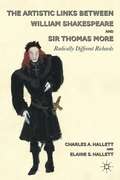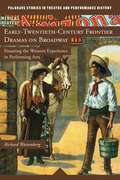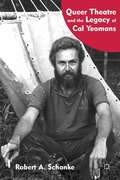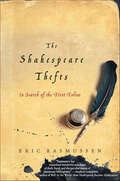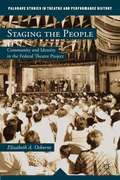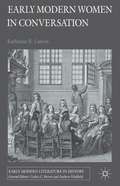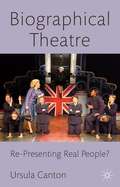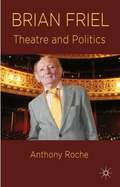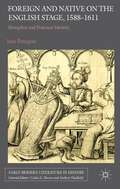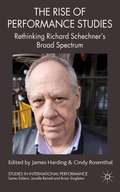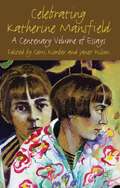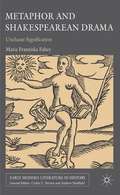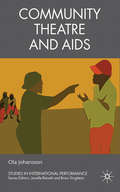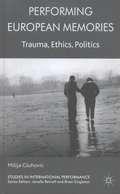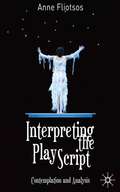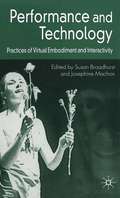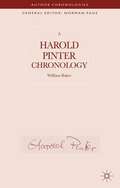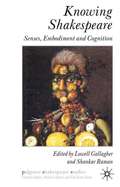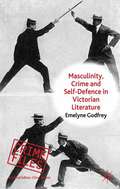- Table View
- List View
The Artistic Links Between William Shakespeare and Sir Thomas More
by Charles A. Hallett Elaine S. HallettApproaching the subject from a dramaturgical point of view, this investigation differs from anything that has been written about the relationship between Thomas More and William Shakespeare. This book defines, in specific terms, what Shakespeare learned from his study of More's "History"and how he exploited that knowledge to heighten the drama. "
Early-Twentieth-Century Frontier Dramas on Broadway
by Richard WattenbergFrontier dramas were among the most popular and successful of early-twentieth-century Broadway type plays. The long runs of contemporary dramas not only indicate the popularity of these plays but also tell us that these plays offered views about the frontier that original audiences could and did embrace.
Queer Theatre And The Legacy Of Cal Yeomans
by Robert A. SchankeA forgotten yet award-winning playwright, Cal Yeomans was one of the founders of gay theater whose work was fueled by gay liberation and extinguished by the AIDS epidemic. Schanke's examination of his life and legacy allows a rare exploration into this pivotal moment of gay American history.
Russian Culture and Theatrical Performance in America, 1891–1933
by Valleri J. HohmanBetween the 1890s and the 1930s, advancements in communication and travel encouraged widespread international cultural exchange, and Americans increasingly came into contact with Russian culture and theatrical performance. A number of factors, including emigration from Russia, world war, revolutionary activities in both Russia and the United States, and developments in modernism in the American theatre influenced the way those performances were received by American artists and audiences. Examining the work of impresarios, financiers, and the press as well as the artists themselves, Hohman demonstrates how a variety of Russian theatrical styles were introduced and incorporated into American theatre and dance.
The Shakespeare Thefts: In Search of the First Folios
by Eric RasmussenPart literary detective story, part Shakespearean lore, The Shakespeare Thefts will charm the Bard's many fans.The first edition of Shakespeare's collected works, the First Folio, published in 1623, is one of the most valuable books in the world and has historically proven to be an attractive target for thieves. Of the 160 First Folios listed in a census of 1902, 14 were subsequently stolen-and only two of these were ever recovered. In his efforts to catalog all these precious First Folios, renowned Shakespeare scholar Eric Rasmussen embarked on a riveting journey around the globe, involving run-ins with heavily tattooed criminal street gangs in Tokyo, bizarre visits with eccentric, reclusive billionaires, and intense battles of wills with secretive librarians. He explores the intrigue surrounding the Earl of Pembroke, arguably Shakespeare's boyfriend, to whom the First Folio is dedicated and whose personal copy is still missing. He investigates the uncanny sequence of events in which a wealthy East Coast couple drowned in a boating accident and the next week their First Folio appeared for sale in Kansas. We hear about Folios that were censored, the pages ripped out of them, about a volume that was marked in red paint-or is it blood?-on every page; and of yet another that has a bullet lodged in its pages.
Staging the People
by Elizabeth A. OsborneThe Federal Theatre Project stands alone as the only national theatre in the history of the United States. This study re-imagines this vital moment in American history, considering the Federal Theatre Project on its own terms - as a "federation of theatres" designed to stimulate new audiences and create locally-relevant theatre during the turbulent 1930s. It integrates a wealth of previously undiscovered archival materials with cultural history, delving into regional activities in Chicago, Boston, Portland, Atlanta, and Birmingham, as well as tours of refugee camps and Civilian Conservation Corps Divisions. For a brief, exhilarating moment, the Federal Theatre Project created a democratic theatre that staged the American people.
Early Modern Women in Conversation
by Katherine R. LarsonTo converse is, in its most fundamental sense, to engage with society. The potency of conversation as an early modern social networking tool is complicated, however, both by its gendered status in the period and by its conflation of verbal and physical interaction. Conversation was an embodied act that signified social intimacy, cohabitation, and even sexual intercourse. As such, conversation posed a particular challenge for women, whose virtuous reputation was contingent on sexual and verbal self-control. Early Modern Women in Conversation considers how five women writers from the prominent Sidney and Cavendish families negotiated the gendered interrelationship between conversation and the spatial boundaries delimiting conversational encounters to create opportunities for authoritative and socially transformative utterance within their texts. Conversation emerges in this book as a powerful rhetorical and creative practice that remaps women's relationship to space and language inearly modern England.
Biographical Theatre
by Ursula CantonMarilyn Monroe, Vincent van Gogh or the victims of rendition flights - the number and variety of historical and contemporary figures represented on British stages is amazing. This book develops a new theoretical framework for the representation of real life figures on stage and examines different ways in which they can be included in performances.
Brian Friel
by Anthony RocheFriel is recognised as Ireland's leading playwright and due to the ability of plays like Translations and Dancing at Lughnasa to translate into other cultures he has made a major impact on world theatre. This study draws on the Friel Archive to deepen our understanding of how his plays were developed.
Re-Visioning Lear’s Daughters
by Lesley Kordecki Karla KoskinenKing Lear is believed by many feminists to be irretrievably sexist. Through detailed line readings supported by a wealth of critical commentary, Re-Visioning Lear's Daughters reconceives Goneril, Regan, and Cordelia as full characters, not stereotypes of good and evil.
Performing Bodies in Pain
by Marla CarlsonThis text analyzes the cultural work of spectacular suffering in contemporary discourse and late-medieval France, reading recent dramatizations of torture and performances of self-mutilating conceptual art against late-medieval saint plays.
Shakespearean Neuroplay
by Amy Cook"Shakespearean Neuroplay" provides a methodology for applying cognitive science to the study of drama and performance. With Shakespeare's "Hamlet" as a test subject and the cognitive linguistic theory of conceptual blending as a tool, Cook unravels the "mirror held up to nature" at the center of Shakespeare's play. Hamlet's mirror becomes a conceptual structure that invisibly scaffolds our understanding of the play. A lucid explanation of both contemporary science and "Hamlet," "Shakespearean Neuroplay" unveils Shakespeare's textual theatrics and sheds light on blind spots in theatre and performance theory.
Extramural Shakespeare
by Denise AlbaneseThis study argues that Shakespeare can now be understood as part of public culture. Thanks to the emergence of mass education in the twentieth century, Albanese argues that Shakespeare has become a shared property, despite the depiction of his texts as 'elite' cultural objects in the film industry.
Foreign and Native on the English Stage, 1588-1611
by Jane PettegreeThis original and scholarly work uses three detailed case studies of plays - Shakespeare's Antony and Cleopatra , King Lear and Cymbeline - to cast light on the ways in which early modern writers used metaphor to explore how identities emerge from the interaction of competing regional and spiritual topographies.
The Rise of Performance Studies
by James M. Harding Cindy RosenthalThe essays in this anthology are situated within the larger context of a critical engagement with Richard Schechner's work as a theatre practitioner, teacher, scholar, activist, and visionary. Through a wide variety of approaches, the contributors acknowledge the profound impact that Schechner's work has had on our understanding of performance as a mode of cultural practice and on the emergence of Performance Studies as a discipline. Some essays are embedded in intensely personal reflections on Schechner's work as a practitioner and teacher, while others take stock of critical concepts that are central to Schechner's work as a theorist and scholar. Yet it is not enough to say that the essays offer a critical survey of the broad spectrum of Schechner's cultural and intellectual endeavours. The essays all converge in an acknowledgement that few individuals within the theatre and performance communities have positioned their work so consistently or so consequentially as Schechner has within the key debates that have defined Performance Studies as a discipline.
Staging and Performing Translation
by Roger Baines Cristina Marinetti Manuela PerteghellaStaging and Performing Translation: Text and Theatre Practice explores the territory between translation theory and practice in contemporary theatre. Featuring contributions by academics from theatre and translation studies, as well as translators, directors, actors, dramaturges and literary managers, and an interview with playwright-translator-adapter Christopher Hampton, this collection attempts to delineate a new space for the discussion of translation in the theatre that is international, critical and scholarly while rooted in experience and understanding of theatre practice. The volume will be of interest to academics, lecturers and postgraduate students working and researching in the fields of translation studies, performance studies, and drama and theatre studies. The book offers innovative approaches to both the translation of play-texts and research methodologies, providing a useful pedagogical tool for the development of theatre translation modules or courses. The practical nature of the contributions will also be of interest to actor-training institutions as well as theatre practitioners and cultural promoters.
Celebrating Katherine Mansfield
by Janet Wilson Gerri KimberA revisionist study of Mansfield as a profoundly colonial yet daringly experimental writer, at the forefront of modernism. The essays in this volume draw on the complete journals, letters and stories, to reveal Mansfield as a modernist who transcended her artistic influences through a supreme understanding of voice, being and subjectivity.
Metaphor and Shakespearean Drama
by Maria Franziska FaheyMetaphor and Shakespearean Drama explores the fruitful and potentiallydisorderly nature of metaphorical utterances in Shakespearean drama. Borrowing its title from Henry Peacham's 1593 warning that 'there be no uncleane or unchast e] signification contained in the Metaphore, ' it explores the worry expressed in Elizabethan rhetoric books that a metaphor might beget illegitimate meanings. Shakespeare's plays demonstrate that a metaphor can indeed generateunruly meanings which, once uttered, have the power to transform a community. Analyses of Othello, Titus Andronicus, Macbeth, King Henry IV Part 1, Hamlet, and The Tempest demonstrate various aspects of metaphoric performance. Theseinclude metaphor's power to import discourses into speech communities; metaphor's sacrificial nature; the relationship between metaphor and equivocation; metaphor's carnivalesque qualities; dead metaphor's ability to haunt living speech; and metaphor'sability to circulate unacknowledged collective fantasies. "
Community Theatre and AIDS (Studies in International Performance)
by Ola JohanssonApplying research into assessments of community theatre, epidemiology, and young people's shared and private stories using a wide range of methodologies, this book explores the potential efficacy of community theatre to prevent the spread of HIV/AIDS in Tanzania with reference to several other comparable sites in Africa.
Performing European Memories
by Milija GluhovicAsking whether a genuinely shared European memory is possible while addressing the dangers of a single, homogenized European memory, Gluhovic examines the contradictions, specificities, continuities and discontinuities in the European shared and unshared pasts as represented in the works of Pinter, Tadeusz Kantor, Heiner Muller and Artur Zmijewski.
Interpreting The Play Script: Contemplation And Analysis
by Anne L. FliotsosOne type of analysis cannot fit every play, nor does one method of interpretation suit every theatre artist or collaborative team. This is the first text to combine traditional and non-traditional models, giving students a range of tools with which to approach different kinds of performance.
Performance and Technology: Practices of Virtual Embodiment and Interactivity (Palgrave Studies In Performance And Technology Ser.)
by Susan Broadhurst Josephine MachonThis collection interrogates the interaction between new technologies and performance practice, linking the sensuous contact that must exist between the physical and virtual, together with the resultant corporeal transformation. It features writings from international contributors who specialize in digital art and performance practices.
A Harold Pinter Chronology
by William BakerThe most detailed chronological account of Harold Pinter to appear, this new volume in the Author Chronologies series traces the daily activities of the Nobel Prize winning author. It is based upon published and unpublished materials, and discussion with his close friends, and is a basic reference tool for all Pinter students and scholars.
Knowing Shakespeare
by Lowell Gallagher Shankar RamanA collection of essays on the ways the senses 'speak' on Shakespeare's stage. Drawing on historical phenomenology, science studies, gender studies and natural philosophy, the essays provide critical tools for understanding Shakespeare's investment in staging the senses.
Masculinity, Crime and Self-Defence in Victorian Literature
by Emelyne GodfreyNow in paperback, this book considers crime fighting from the perspective of the civilian city-goer, from the mid-Victorian garotting panics to 1914. It charts the shift from the use of body armour to the adoption of exotic martial arts through the works of popular playwrights and novelists, examining changing ideals of urban, middle-class heroism.
